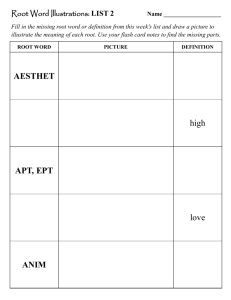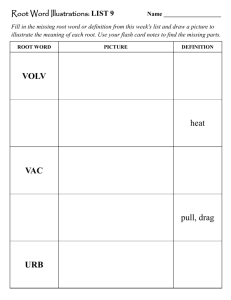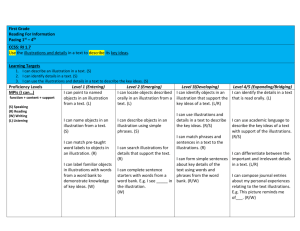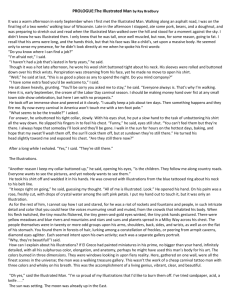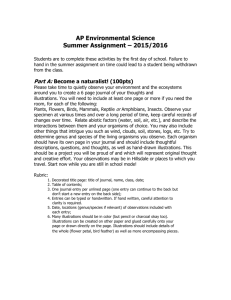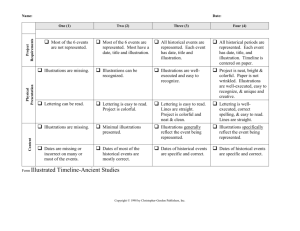McLane_Clara_Sharon_Illustration_Unit
advertisement
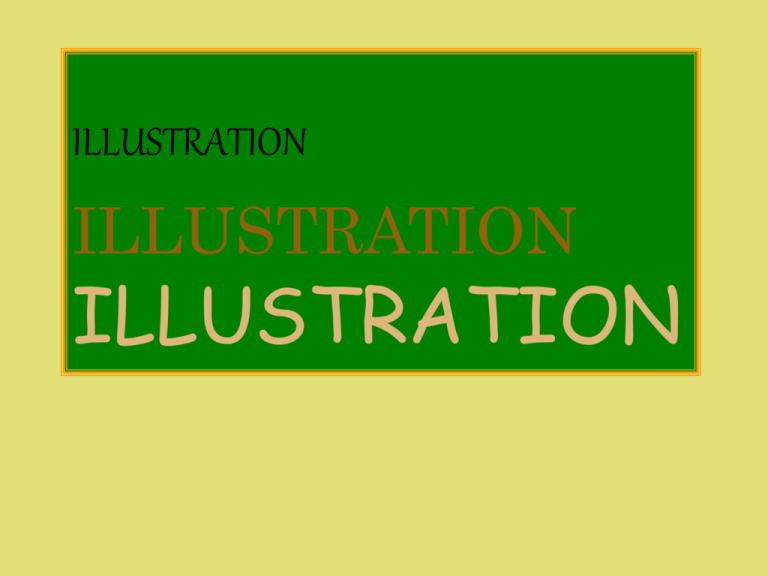
ILLUSTRATION ILLUSTRATION ILLUSTRATION Cave Painting, Lascaux, France, 20,000 years old Cave Painting, Lascaux, France 20,000 years old Eagle Ranch Cave Painting, Australia 4000 years old Cave Painting Australia Date Unknown Petroglyphs Utah Petroglyph, Utah Freemont Period 500AD – 1500AD Navajo Pictograph Utah, after 1540 AD Cuneiform Clay Tablet, Mesopotamia, 5000 years old Sumerian Cuneiform Script 4500 years old Egyptian Pyramid Text 3000 years old Heiroglyphs from the “Papyrus of Ani,” Book of the Dead Egypt, 1292 BC – 1185 BC Papyrus fragment of a spell from the Book of the Dead written for Nes-pauti-taui, Egypt c. 1000 BC Illustration from the Papyrus of Ani Ani and his wife bow, while the god Anubis weighs Ani’s heart against the feather of truth. Papyrus of Nany, a woman in her seventies, chantress of Amun-Re. She holds her mouth and eyes in her hand, while her heart is weighed. Maya Codices (Books) Heiroglyphics written on amatyl paper Yucatan, c. 1500 AD Many such records of Mayan civilization were destroyed by the Spanish Conquistadors and priests in 1562. Only three remain. Medieval Illuminated Manuscripts “Book of Kells” Four Gospels with Latin text Ireland, c. 800 AD Book Cover with Byzantine Icon of the Crucifixion Ivory icon carved about 1000 AD in Constantinople. Book cover gilded silver on wood backing, set with sapphires, glass and crystal, made in Spain before 1085 AD. Hand-Written Manuscript Tempera and gold leaf with brown ink on parchment. French, c.1290 AD “The Entombment” Tempera colors and gold leaf on parchment Attributed to Masters of Dirc van Delf, Dutch Utrecht, c. 1405-1410 AD “Hours of Simon de Varie,” Illuminated by Jean Fouquet Tempera colors, gold leaf, gold paint, & iron gall ink on parchment, covered with red morocco (soft goatskin leather). French, 1455 AD “Book of Hours,” 167 leaves of vellum Valencia, Spain, c. 1460 Breviary belonging to Mary Stuart, Queen of Scots Her notes can be seen in the margins Late 1400s AD Printed Manuscripts Appear with the Renaissance Italian Bible, Book 2 Printed text with Handcolored Woodcut Illustrations “Poliphilo’s Dream about the Strife of Love” by Colonna Woodcut illustrations with printed text, Venice, 1499 “The Dissection” by Johannes de Ketham Printed medical book with woodcut illustrations which have been colored using stencils or hand-pressed color blocks. “Zodiac Man” Chart combining medicine and astrology, used by doctors to determine the best time to operate or let blood from certain organs. Italian, 1400-1600 AD Modern Illustration serves many purposes Illustrated books are still used for instruction. “Gray’s Anatomy” 1977 Illustrations can be used to add information to scientific or technical texts. “Large as Life, Daytime Animals” Text by Joanna Cole Illustrations by Kenneth Lilly 1985 Photography and digital artwork is often used to illustrate products. Text is frequently treated as a graphic component, adding visual interest to illustrations, particularly in advertising. Illustrations can be used to provide conceptual images. “Effigia okeefeae,” related to the forbears of modern crocodiles. National Geographic, March 2007 Illustrations can be used to influence. Newspaper illustration by Frederick Remington. William Randolph Hearst, owner of the paper, allegedly told Remington, “You supply the drawings. I’ll supply the war.” Such inflammatory drawings and stories influenced the decision to enter the Spanish American War in 1896. Illustrations can add a great deal to Creative Writing. In the late 1800s, illustrators created images full of action for novels and historical fiction. “On the Irrawaddy” by G.A. Henty, 1896 “Five Little Peppers & How They Grew,” by Margaret Sidney, 1881 Text is absorbed and understood in a linear manner. In most cultures, this travels from left to right and top to bottom. The movie Ice Age features: a mammoth, a sabertooth, a squirrel and a sloth. Visual images are absorbed and understood all at once. Text and Illustrations are both symbol systems. Language is an expression of thought. Written language is an expression of verbal language. Understanding is achieved through mastery of vocabulary, grammar and syntax. Rich mental images and emotional response are achieved through metaphor, simile, rhythm and tone. Visual images incorporate many symbols within specific cultural contexts. Illustrations provide a wide range of images, from realistic to suggestive to abstract. Through the use of color and other elements, visual images elicit emotional responses, often without engaging the language/thought process. Congruency Faithful depiction of what is written “Under the Window” by Kate Greenaway 1879 Simplification Background and other information is excluded. “The Country Bunny and the Little Golden Shoes,” by Du Bose Heyward, Illustrated by Marjorie Flack 1939 Elaboration An extension of what is written “The Day Jimmy’s Boa Ate the Wash” by Trinka Hakes Noble Illustration by Steven Kellogg 1980 Foretelling Hinting at an event which has not happened in the story yet “Raggedy Ann and Andy and the Wishing Pebble” Illustrated by Cathy Beylon 1987 Deviation When the illustrator adds visual information beyond what is written, the story can be enhanced or expanded. If the illustrator chooses to create images which are in opposition to what is written, the story can become a farce or satire. Continuous Narration Simplest type of illustration A series of pictures depict the action of the narrative. “There’s a Nightmare in My Closet” Written and illustrated by Mercer Mayer 1968 Continuous Narrative Illustration is often used in books for young children who cannot read. “Owl At Home” Written & illustrated by Arnold Loble, 1975 Illustrating motion can be achieved by using diagonal lines Show motion or time with multiple images Time and Change can evolve over several pages “Once There Was a Tree” Written by Natalia Romanova Illustrated by Gennady Spirin 1983 Border Decorations Simple or elaborate, they tie the pages together as a whole. Perspective Visual interest can be added by varying the viewpoint. “The Glassmakers of Gurven” Written by Marlys Boddy Illustrated by Joe Boddy Personification Objects or animals portrayed as human “Aesop’s Fables” Illustrated by Arthur Rackham Facsimile of 1912 edition Disney and many others use personification. Different art styles can work for the same story By Daniel San Souci By Anne Rockwell “Where the Sidewalk Ends” 1987 Line Art Poems and Drawings by Shel Silverstein “Salome: The Peacock Skirt” Pen and ink by Aubrey Beardsley 1894 Use bold shapes to create drama Pen and Ink “Portrait of James McNeill Whistler” Aubrey Beardsley 1894 Use juxtaposition to create fantasy or dream images “The Ecstacy of St. Rose of Lima” Pen and ink by Aubrey Beardsley 1896 Use facial expression and body language to tell the story “Alexander and the Terrible, Horrible, No Good, Very Bad Day” By Judith Viorst Illustrationed by Ray Cruz 1972 Cartoons can be very effective By Tedd Arnold Illustrations do not have to be detailed to be effective. “The Long Day” by Ben Wohlberg, 1961 Color creates mood “Glassmakers of Gurven” Illustrated by Joe Boddy “First Snow” by John Gannam Unusual composition adds interest Illustration for Pacific Mills By John Gannam Some illustrations require no text at all. . . . . . . . . . . . . . .

